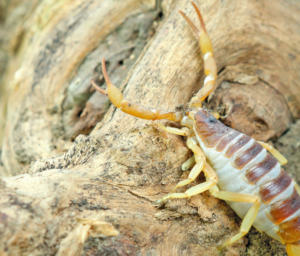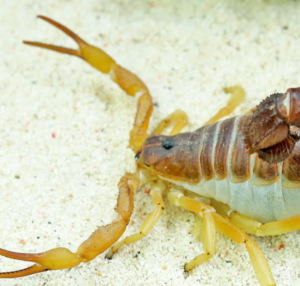The Parabuthus liosoma, also known as the African Black-Tailed Scorpion or Black-tipped Scorpion, is well known in hobby circles as one of the most colorful hot scorpions for budding entomologists to keep.
According to John Chua, although the Parabuthus liosoma is not that big (usually reaching up to 70mm or 2.8 inches), its striking appearance, with its distinctive fat black tail and desert coloration, makes it a must-have in anyone’s collection.

Desert Mystery
Many things about the African Black-Tailed Scorpion add to its mystique. These scorpions tend to live in dry, arid environments with soils that are a mixture of sand, clay, and gravel, where their desert coloration provides them with some camouflage. They stay away from places that have the amounts of rainfall required for intensive agriculture. As a result, they tend to live in places away from human populations.
Their distinctive black-tipped tails also warn everyone of a painful sting if they risk approaching. John explains, “One of the biggest misconceptions about scorpions in general is that they will purposely hunt you down and make you its meal. This is obviously not true, as scorpions are more of a flight than fight creature. Its venom can still put you in a world of pain that you can’t imagine. However, only a few scorpions can really kill humans with their venom, and P. liosoma is not one of them.”
There are no reported deaths from P. liosoma stings. One reported case from Saudi Arabia concerns a 50-year-old female, who was stung in the toe and immediately felt a persistent pain in her lower extremities, followed by hypotension, anxiety, and agitation. No anti-venom was used, and her condition improved after three hours, although the local pain from the sting didn’t go away until three days later. Fortunately, unlike other Parabuthus scorpions, P. liosoma appears to have no ability to squirt venom from a distance.
Don’t Pet the Scorpion!
A common and dangerous misconception among those outside the hobby is that “tame” scorpions do not sting and can easily be handled. John says, “The first rule of keeping hot scorpions is: No petting. You can look at them and admire them inside their enclosures, but no touching or petting is allowed. Scorpions are not like cats and dogs. They can’t show you affection. If you try they will run and hide, or give you the stinger.”
It is very important for scorpion owners to maintain a sensible attitude toward the animal. Owning a scorpion just so you can show it off to your friends is extremely irresponsible—and if that’s your reason for wanting one, then it’s a clear sign you shouldn’t have one.
As for those who have chosen to take the plunge and are looking for tips for handling their pet, John’s advice is worth repeating. Keep the scorpion inside its housing and admire it from afar. The safest rule is: Never handle your scorpion.
Housing and Care

Caring for P. liosoma is pretty basic, says John. The main requirements for housing scorpions, like all invertebrate pets, is that the enclosure is secure, and that it can be maintained at an appropriate temperature and humidity.
A medium or large critter keeper will do for adult and sub-adult specimens, and scorplings can be kept in medium-sized plastic containers with holes for air. Place coco peat and coarse sand for substrate, and place stones or a false bottom hide for privacy.
Always watch the humidity! Desert scorpions like P. liosoma are vulnerable to fungal infections if housing is too humid. Still, John recommends that busy owners leave a water dish in the enclosure or do infrequent misting.
Keep daytime temperatures high—ideally 30-35 degrees Celsius—and ensure a nighttime temperature drop of about 25 degrees, as this is essential for the scorpion’s development. This cooldown gives the scorpion time to rest from the desert sun, and space to feed in a relaxed environment.
Epic Mealtime
All scorpions are carnivores, and eat a variety of insects and invertebrates. John recommends a diet of crickets, roaches, superworms, and mealworms. Adults and sub-adults can be fed with one adult cricket or worm every week, or a locust or adult cockroach once a month.
As a treat, you can feed your P. liosoma a pinkie worm once a month, or even twice a month (if the pinkie worms are available), but no more than that. The sight of a scorpion eating a pinkie mouse is truly something to behold.
It is often best to feed your scorpions at night so that their behavior matches that of wild scorpions. If your scorpion doesn’t eat or leaves leftovers, it could be a sign that it is being kept in improper conditions, so pay attention to your little guy’s appetite.
Virgin Birth

Another fascinating thing about P. liosoma, notes, is that recently, some specimens have exhibited parthenogenesis. The word “parthenogenesis” comes from Greek, means “virgin creation,” and refers to a natural form of reproduction that occurs without fertilization—that is, without sex. In animals, this refers to the development of an embryo from an unfertilized egg cell. This allows the scorpion to reproduce even without a mate, which may probably come as a great surprise to first-time keepers of single specimens.
John says, “Not all P. liosoma exhibit parthenogenetic qualities, however. But this makes them unique when compared to other Parabuthus species.”
Quick Facts: Parabuthus liosoma
Kingdom: Animalia
Phylum: Arthropoda
Class: Arachnida
Order: Scorpiones
Family: Buthidae
Genus: Parabuthus
Species: P. liosoma
Color: Yellow to reddish-brown, with darker, violet-black, or black last two metasoma segments
Size: 70mm or 2.8 in, with males generally smaller than females
Lifespan: typically 4-5 years
Present in: Eastern and Northeastern Africa (Egypt, Ethiopia, Kenya, Somalia, Sudan, Tanzania), and the Arabian Peninsula (Saudi Arabia, Yemen).
Habitat: Under stones and debris in arid or semi-arid environments, such as desert, grassland, and savannah. Moderate humidity. Does not dig burrows, but uses natural spaces or burrows under stones and other objects.
This appeared in Animal Scene’s March 2016 issue.






